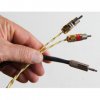I always assumed that you need shielding on signal cables, especially the ones that
connect the source like CD Player or a Turntable and a Preamp. The shielding forms
a sort of electrical barrier around the conductor that is actually carrying the
signal against Electromagnetic Interference EMF/EMI and Noise like Transformer Hums, Tube light choke spikes etc.
If this the case wont the following braided cable offer absolutely no protection against EMF/EMI and would actually be worse than even the cheapest shielded cable ? So why are these fancy
Cable companies charging so much more for what is actually an absolutely inferior product ? It looks like the twisted Red+Black electrical wire used connected to RCA plugs.
Do they assume we don't even know basic electronic knowledge about shielding a signal cable
or
Are each of those braided wires are actually shielded cables and not individual wires ?
connect the source like CD Player or a Turntable and a Preamp. The shielding forms
a sort of electrical barrier around the conductor that is actually carrying the
signal against Electromagnetic Interference EMF/EMI and Noise like Transformer Hums, Tube light choke spikes etc.
If this the case wont the following braided cable offer absolutely no protection against EMF/EMI and would actually be worse than even the cheapest shielded cable ? So why are these fancy
Cable companies charging so much more for what is actually an absolutely inferior product ? It looks like the twisted Red+Black electrical wire used connected to RCA plugs.
Do they assume we don't even know basic electronic knowledge about shielding a signal cable
or
Are each of those braided wires are actually shielded cables and not individual wires ?




